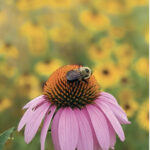A wide river. A rich history. Smooth government buildings balanced by planned green spaces. Meandering streets that twist and turn through Uptown, Midtown and downtown. Architecture with charisma. Harrisburg is a city worth exploring. City schools take advantage of its attributes all year long.
“We use the entire city as an extended campus,” affirmed David Rushinski, principal of Harrisburg Catholic Elementary School. He said that parents who enroll their children in the city campus note the phenomenal benefits of being next door to cultural, scientific and performance venues.
A valuable asset of Harrisburg is that it is such a walkable city.
“It’s simplified to schedule field trips almost every week to locations right around the corner such as the Whitaker Center, the planetarium or Strawberry Square to see the Popcorn Hat Players,” he said. “Plus, all of our students receive a year-long membership to the State Museum.”
St. Stephen’s Episcopal School on Front Street uses its picturesque spot in the city as a resource for several aspects of learning, from simple to more complex. Fall mornings are spent playing in Riverfront Park during recess.
“We don’t have a huge campus, so we are especially vigilant in how we use the space and the community around us,” said Ellen Konkle, development and alumni coordinator for the school.
The students enjoy walking to the Dauphin County Library, where they sign up for library cards and spend afternoons at the YMCA for swimming and gym class. “The takeaway is that it makes our students grateful for being an integral part of a community,” she said. “They learn civic responsibility by appreciating city parks, knowing that they are invested in making public space a nice place to enjoy.”
This is the next generation of city leaders, according to Konkle, and the valuable insight they gain from every day experiences in a cultural city boosts all levels of learning. “Also, the use of city resources in our curriculum is one of the most unique factors about St. Stephen’s and one that many alumni recount as a reason they think so fondly of their days with us.”
Caleb Smith, film and video teacher at Capital Area School for the Arts Charter School (CASA), said that, in his curriculum, students work on a variety of video projects, including narratives and music videos.
“Location makes a strong impression when used correctly, and, rather than having all the scenarios take place in locker-lined hallways, we use the city as our classroom with a large variety of close places,” he said.
For example, students have used Riverfront Park and the Walnut Street Bridge for recognizable and nature-oriented locations, he said. The Capitol steps down to 2nd Street provide an older look for shoots, while the modern buildings around Strawberry Square evoke yet another mood.
“The city is our classroom and also the location and background to almost all of our productions,” he said.
Books & Bridges
If writing is a student’s passion, there’s no need to venture far to find the perfect place for inspiration.
“Creative writing typically takes a ‘field trip’ to the Midtown Scholar Bookstore, where the writers get to explore the plethora of books,” said CASA creative writing teacher Ann Stewart. “When we enter, someone invariably notes, with a near-swoon, the aroma of musty books, pungent coffee and polished wood. To a writer, that’s heaven.”
The river along Front Street is a strong source of inspiration as well, remarked CASA dance teacher Rosemary Battista. Dance students visit the river every year to observe nature: not only the power of the water, but also the peace and tranquility that it provides.
In addition, students often comment on the bridges and relate their lines and form to the shapes they make when they dance. Often, the students create strong, emotional choreography from the contrast of the city noises and the quiet beauty of nature, she said.
Jackie Kosoff of Hershey graduated from CASA last year and is now majoring in dance at Montclair State University in New Jersey. She attests that the exercise by the Susquehanna provided an energetic muse.
“It opened my mind to a new way of thinking and finding a source for inspiration,” she said. “We take that experience and remember not to limit ourselves. It is a lesson that I carry with me now and will use in my studies. And it started as a quiet time taking notes on the energy of Harrisburg.”
The river is also used for scientific lessons to educate students on the history of floods in the region. Harrisburg School District pupils studied the high water mark from Agnes and tied the experience to a unit on weather, climate and watersheds, learning the causes of floods and how to be prepared.
In fact, nature provides many opportunities for students to get out and about in the city.
CASA students spent a day identifying native Pennsylvania trees on the Capitol lawn using keys provided by the state Department of Conservation and Natural Resources. Meanwhile, Camp Curtin School students celebrated the 25th anniversary of Arbor Day last spring with the Harrisburg Department of Parks, Recreation & Enrichment at the Italian Lake band shell. They were able to assist and learn more about the important effect trees have in our communities and how urban and community parks provide value.
Speaking of nature, Harrisburg’s Math Science Academy partners with Harrisburg Inner City Outings, a local nonprofit, to provide life-changing experiences for Harrisburg youth.
“Over the last seven years, we have completed more than 70 outings with 300 or more Math Science Academy students participating in the program,” said teacher Judd Pittman.
He said that Harrisburg students have hiked to Hawk Rock and Pole Steeple and paddled the Susquehanna and Juniata Rivers.
Students also participated in The Sierra Club-sponsored Susquehanna River Clean Up and Friends of Midtown’s annual fall clean up.
“The students have gained a deeper appreciation regarding their impact on and relationship with the natural world,” said Pittman. “The experiences students have on Saturdays are often expressed through blogs and student-generated write-ups in the school newsletter, bringing full circle the connection between school and the opportunities afforded our students through Harrisburg Inner City Outings.”
Lessons from the Past, Present
The Harrisburg Cemetery sits in somber contrast to the spirited stories of former city residents buried there. Here is where local historian George Nagle brings tales of mid-1800s Harrisburg abolitionists to life for local high school students. A member of the Camp Curtin Historical Society, Nagle leads a field trip each fall to teach about people who were critical national figures in the anti-slavery argument raging during the pre-Civil War era.
Harrisburg Academy senior Hannah Shea of Susquehanna Township attended the cemetery field trip to one of the city’s best-kept historical secrets. “It really put the stories of past national debate in context for me,” she said. “People from Harrisburg influenced the anti-slavery movement and participated in the Underground Railroad. I gained a deepened understanding from learning in such a meaningful atmosphere.”
Harrisburg Academy’s original location was the John Harris-Simon Cameron Mansion. “Our entire school community still returns to the city for our holiday concert at the Forum featuring student performers and for our commencement ceremonies at the Scottish Rite Cathedral,” said Kristina Pae, director of communications for the school.
Academy students of all ages participate in field trips in the city, including performances at the Gamut Theatre and the Scottish Rite Theatre, attendance at the Farm Show, tours of the state Capitol and visits to the Rachel Carson Building for presentations about the peregrine falcon banding. They go on walking tours of historic Uptown Harrisburg, visit the National Civil War Museum, explore the Susquehanna River, attend the Capital Area Science & Engineering Fair at Whitaker Center and watch educational films at Midtown Cinema.
In addition, each graduating senior concludes his or her final year with a three-week internship at a local business or organization.
“The resources of the city are readily available, and companies are willing to reach out in partnership to the school,” said Pae.
In 2012 alone, students interned at the State Street Academy of Music, Harrisburg Law Bureau, Pennsylvania State Museum, state Bureau of Forestry, Kutztown University Small Business Development Center, Equality PA and the East Shore YMCA, she said.
Other resources in the city offer a social and community service aspect to learning for all students.
For instance, the Harrisburg School District partners with local organizations to provide weekend food for needy families through the Power Pack program, sponsored by PinnacleHealth and the Central PA Food Bank. The life skills classroom at Camp Curtin bags the food, which is then picked up by the district courier, who delivers it to the schools.
“A bag full of non-perishable food goes home every Friday at the end of the school day to families who need extra help with food because sometimes some of our students do not eat on the weekends and come to school on Mondays starving,” said Laura Bloss, Harrisburg School District’s homelessness liaison. “This relates to curriculum in many ways. When our students have food and healthy nutrition, they are able to focus better in school. Also, our Life Skills students do the packing of the food, so they are getting skills for work like they would at a grocery store by keeping inventory and keeping track of the bags that are filled.”
Harrisburg schools also work with The Highmark Caring Place, which champions the cause of grieving children by creating awareness of their needs, providing programs for them and their families, and empowering the community to effectively support them.
“The Harrisburg High School SciTech campus has been sending a group to Highmark for several years, and it is one of our most popular partners for the students,” said SciTech Community Partnership Development Director Doug Reitz. “SciTech students help with the children’s grief center where young children are provided counseling to help them cope with the loss of a loved one. We send a group each month of the school year for community service work.”
Opportunity for learning abounds throughout the city, and every destination seems to be right around the corner.
“A hands-on experience of learning always trumps traditional classroom work,” said Harrisburg Catholic’s Rushinski. “We are fortunate to have a wide array of opportunities this city offers us.”






